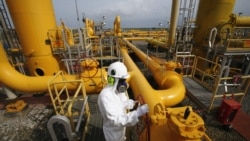Limited access to reliable energy and power resources represents one of the largest obstacles to economic growth in South East Asia. Due to increasing demand throughout Asia, the International Energy Agency estimates the region will require $9 trillion in energy investments by 2035.
U.S. Special Envoy and Coordinator for International Energy Affairs Carlos Pascual says Asia is driving global energy demand growth, and therefore the choices countries in the region make with regards to energy infrastructure are critical.
“The nature of these investments, whether it’s in coal or oil or gas or renewable energy - is going to fundamentally determine the fate of the planet. Sustainability – our ability to limit or even reduce greenhouse gas emissions - fundamentally depends on it. Economic competitiveness depends on it.”
This is why the U.S. Department of State, the U.S. Trade and Development Agency (TDA), and the Overseas Private Investment Corporation (OPIC) are launching the Asia-Pacific Clean Energy Program. The program, as Ambassador Pascual explained during a recent round-table event, will facilitate investment in renewable and cleaner energy technology and interconnectivity:
“We want to be able to work together with Asian countries to be able to address both of these issues: to stimulate investments that allow effective competition and productivity within Asia, but to do it in a way that results in a sustainable planet.”
As part of a larger U.S.-Asia-Pacific Comprehensive Energy Partnership, the clean energy program will for the first time co-locate OPIC and TDA personnel in the U.S. embassy in Bangkok, where they will help to maximize the disbursement of $6 billion in U.S. financing resources to support clean and renewable energy investments and U.S. exports throughout the region. The program will provide tools such as loans, political risk insurance, project preparation and technical assistance support, while creating opportunities for U.S. companies to partner with local industry.
Ambassador Pascual says the Clean Energy Program will be critical in helping countries in the Asia Pacific move away from carbon intensive energy sources to a more sustainable development path.
“We believe that’s possible,” said Ambassador Pascual, “and that’s what we’re trying to do through this initiative.”
U.S. Special Envoy and Coordinator for International Energy Affairs Carlos Pascual says Asia is driving global energy demand growth, and therefore the choices countries in the region make with regards to energy infrastructure are critical.
“The nature of these investments, whether it’s in coal or oil or gas or renewable energy - is going to fundamentally determine the fate of the planet. Sustainability – our ability to limit or even reduce greenhouse gas emissions - fundamentally depends on it. Economic competitiveness depends on it.”
This is why the U.S. Department of State, the U.S. Trade and Development Agency (TDA), and the Overseas Private Investment Corporation (OPIC) are launching the Asia-Pacific Clean Energy Program. The program, as Ambassador Pascual explained during a recent round-table event, will facilitate investment in renewable and cleaner energy technology and interconnectivity:
“We want to be able to work together with Asian countries to be able to address both of these issues: to stimulate investments that allow effective competition and productivity within Asia, but to do it in a way that results in a sustainable planet.”
As part of a larger U.S.-Asia-Pacific Comprehensive Energy Partnership, the clean energy program will for the first time co-locate OPIC and TDA personnel in the U.S. embassy in Bangkok, where they will help to maximize the disbursement of $6 billion in U.S. financing resources to support clean and renewable energy investments and U.S. exports throughout the region. The program will provide tools such as loans, political risk insurance, project preparation and technical assistance support, while creating opportunities for U.S. companies to partner with local industry.
Ambassador Pascual says the Clean Energy Program will be critical in helping countries in the Asia Pacific move away from carbon intensive energy sources to a more sustainable development path.
“We believe that’s possible,” said Ambassador Pascual, “and that’s what we’re trying to do through this initiative.”

















